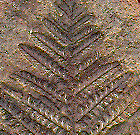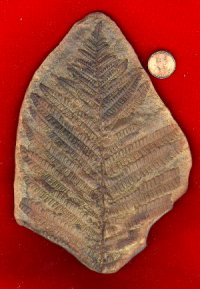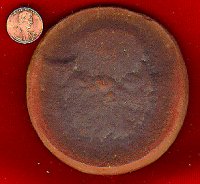 |
|||
|
|||
|
Copyright
Collecting Fossils with Canadian Rockhounds at Mazon Creek
Wysocki, you see, is the field trip coordinator for the Mazon Creek Project. As you may know, Mazon Creek is world famous for its fossil biota that stretches across Illinois and Missouri. After reading the article, she e-mailed me and invited me to attend one of her field trips. It just so happened that one of our friends, a newspaper columnist, interviewed Gina a few weeks before. Knowing that my brother and I were fossil lovers, she also invited us. We quickly accepted both invitations, and on April 25th we boarded a van that would take us from our Ottawa home to the Braidwood, IL cooling lake, some 40 miles away. While the biota stretches across a group of states, most of its fossil riches are centered near Braidwood, and we were very excited about the possibility of discovering something amazing. We arrived at about 8:30, and boarded a van that would take us to our first destination: the shores of the cooling lake. When we arrived our group was greeted with the grim news that an un-permitted amateur had illegally collected at the pit the afternoon before. While the past week's rain greeted us with the prospect of the erosion of fossil bearing concretions, our guide's news did not sit too well. After one quick look he told us that the site had been terribly picked over. We knew trouble was ahead.
Our fears quickly turned to reality after fifteen fossil-less minutes passed by. Then came another fifteen, and then another. Finally, after about 45 minutes, we located our first concretion on a hill dubbed Insect Mountain. It was a beautiful, inch long oval rock that was immediately identified by our guide as fossil bearing. We were excited, but knew deep down that one mere concretion in 45 minutes was very poor, and we needed to do better. We decided to stay on Insect Mountain, and our decision was rewarded with the discovery of five more concretions in just twenty minutes. We were finally starting to get the hang of collecting at Mazon when our guides told us that it was time to leave. My family and I boarded the bus once again and were dropped off at camp, where we decided to eat lunch. After our lunch we moseyed up to the center of camp, where I first met Gina personally. We shared a conversation, and she showed me a few nicely fossilized shrimp. I marveled at them, and was surprised when she offered them to me. I quickly took them, and thanked her. The shrimp were our best fossils of the day, at least for the time being. After Gina handed us the fossils, she told us of another trip. This one, she explained, was a small group outing to a private strip mine spoil pile. Only a select few could come along, and the guides were leaving in fifteen minutes. We decided to tag along, a decision that would prove valuable in the near future. This decision turned out to be our best of the day. We boarded yet another bus and were let off at yet another location. This time, we had to walk a quarter of a mile before reaching our destination. Our feet ached, our arms were in pain, but we knew good times awaited us. We eventually arrived at the spoil pile, and were amazed at just how few people were there. Unlike at the cooling lake, there was enough room to spread out a bit. And, that we did. Each family member took their own crevasse and began to carefully look for the iron red colored concretions. My brother Mike made the first major discovery of the day-a jellyfish fragment. Until that time, we had found nothing of significance, and this find motivated us to continue. I briskly jogged up a hill and dropped down to my knees. I was longing to find a jellyfish fragment, and a few moments later I laid my eyes on one fourth of a concretion. There seemed to be a slight indentation, a slight imprint you may say, so I rushed to show it to our guide. He took a look, and identified it as a jellyfish fragment. Not great, but a start, I told myself. My other brother, Chris, also discovered a jellyfish fragment, and so did my mother. My brother Mike found another, too. Realizing that it was a good day for jellyfish collecting, Chris was assigned to one side of the spoil pile, I took another, and Mike and my mother volunteered to explore the front. We all knew what we had to find, and went about with our goal implanted in our mind. Just a few moments after our separation, I brought back a jellyfish piece to show to the rest of the family and get properly identified by our guide. While I was there showing off my latest find, Mike and my mother walked up with a few cracked concretions and proceeded to question if they represented anything of significance. Our guide quickly shifted though them, periodically tossing junk pieces to the rocky ground. With every toss our hopes were dashed further, until an odd smile came over our guide's face. A shriek followed the smile, and then our guide began to rub the thick cake of dirt off of the surface of one of the rocks. The frantic cleaning was followed by, "this is the best jellyfish fragment I have seen all day!" We were amazed, and so was he. Knowing we only had one half, Mike and my mother led the guide to their spot of discovery, and within seconds he located the other half of the jellyfish-bearing concretion. He quickly cleaned it, too, and handed me the finished piece. I looked down in my hand and saw an absolutely beautiful fossil of a Pennsylvanian jellyfish, which our guide assigned to the species Essexella asherae. I held it up to the sun and stared in awe at the perfectly preserved medusa. I do not have a trained fossil eye. I can't tell a smudge from an ancient worm, or a blur from an ancient fern. But, I could clearly see all of the features of the jellyfish. Our guide also began to look with me, and pointed out the rarely preserved feeding tube. As with the medusa, I could also clearly see the tube.
When we arrived back at "base camp" I showed Gina and she too was surprised. We then had to tell her good bye. It was now time for us to leave the Mazonia outcrops, unsure what awaited us in our unopened concretions, but amazed at our last second discovery. The sunstroke had caught up to us, but our spirits still soared along with the magical jellyfish, which had received its first ray of sunlight in over 300 million years. Now, amazed as I was, or you may be, at the discovery, we do have to realize that Essexella jellyfish are some of the most common fossils unearthed at Mazon. Although their lack of hard parts makes fossilization rare in most parts of the world, the ancient Mazon coal forests provided an ideal location for remarkably ideal fossilization. This point can be proven by our discovery of several jellyfish fragments. But, once again, I must accent the word fragments. Only one of our jellyfish was complete, and finding one of these whole fossils is becoming rarer and rarer with the digging of each determined collector and each passing rain storm. In all reality, our find was a somewhat common one, but it made the day worthwhile. As of now, none of our collected concretions have yielded any fossils. I am still freeze-thawing them, hammering them, and praying that I can crack open a remarkable new discovery. I realize the possibility that none of our concretions may be fossil bearing, but regardless of what turns up, our jellyfish has encouraged us to return to Mazon. Hopefully, it will also encourage our Canadian friends to once again make the long trip to Illinois.
Permission is given to freely reprint this article from the Canadian Rockhound for non-commercial and educational purposes, provided the author and the Canadian Rockhound are acknowledged, and that the website URL address of the Canadian Rockhound is given. The article may not be edited or rewritten to change its meaning or substance without the author's permission. To contact the author, please use the e-mail address provided. Photos of the Mazon Creek fossils are copyright ©1995 by Illinois State Museum, Illinois, USA. They are used here for educational purposes. More fossils can be viewed online by going to the online Mazon Creek Exhibit maintained by the Illinois State Museum. Photos used with permission.
|
||||||||

Copyright © 1999 Canadian Rockhound
Magazine Issues |
News & Events |
Junior Rockhound |
Resources
|
|||||||||


 Essexella asherae, a scyphomedusan jellyfish. This image shows the organism's manubrium (bell). Coin 19 mm. ©1995
Essexella asherae, a scyphomedusan jellyfish. This image shows the organism's manubrium (bell). Coin 19 mm. ©1995